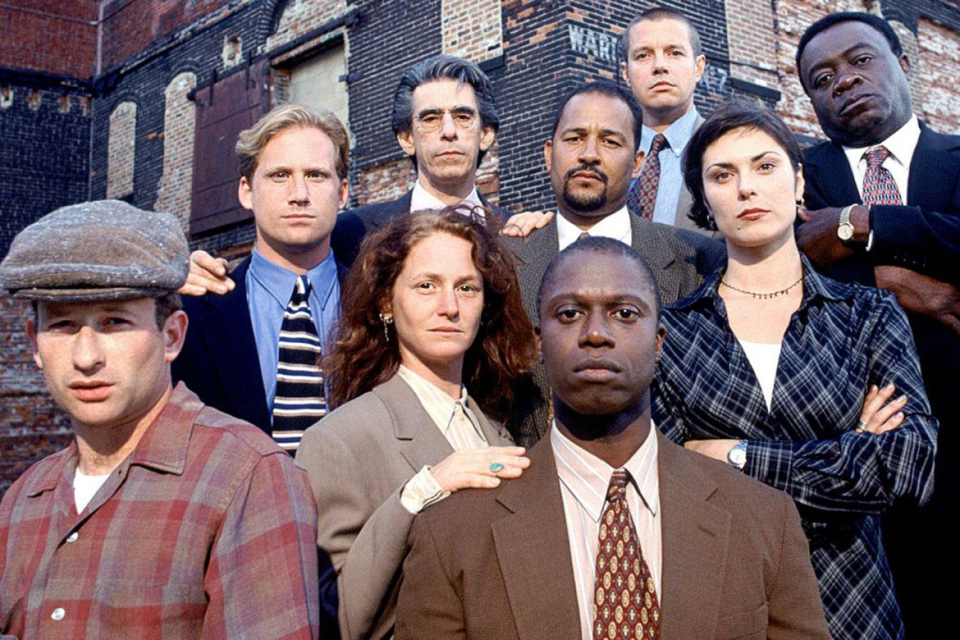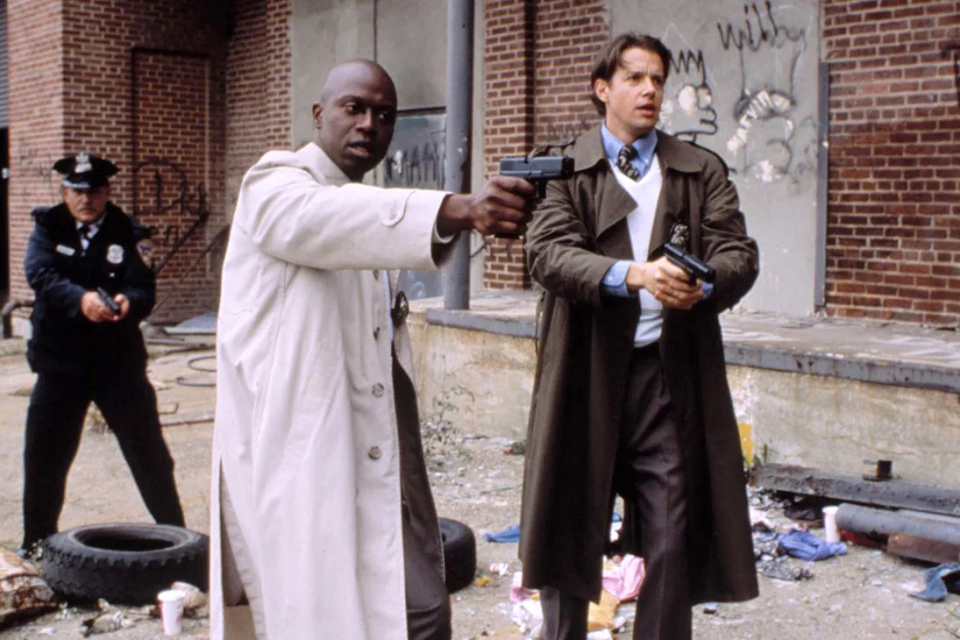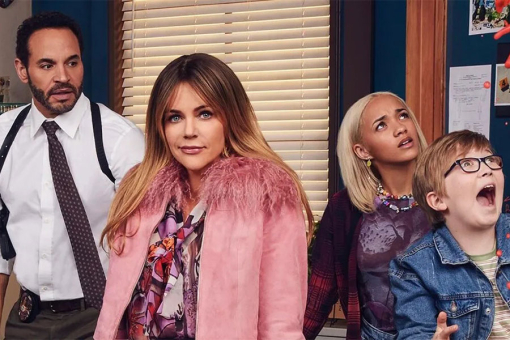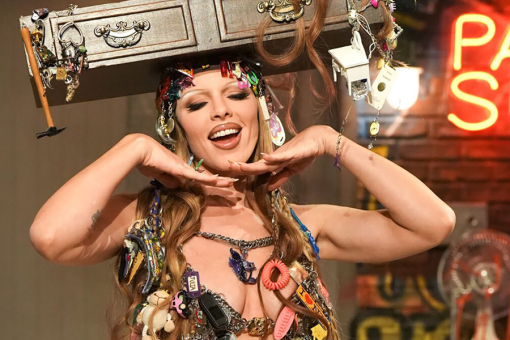A cop show, but with no gun battles and no car chases? That’s what Homicide: Life on the Street set out to be when it premiered three decades ago this year. Lauded by TV Guide as “The Best Show You’re Not Watching” given its consistently low Nielsen ratings, the dark and biting series lasted seven years on NBC.
Homicide was groundbreaking for several reasons. It explored the detectives’ psyches and personalities, it sometimes left murder cases unsolved and the entire series was filmed using a handheld Super 16mm camera, with often-vertiginous jump-cut and smash-cut edits. Also notable for its diverse cast, Homicide was a critics’ darling and won four Emmy Awards, three Peabodys and many other honors. But NBC nearly dropped it after its first season. A guest-starring appearance by Robin Williams (“Bop Gun”) saved it from cancellation and bought it a second season — of just four episodes.
Other guest stars included prominent performers who at the time weren’t known for TV work, including Kathy Bates, Steve Buscemi, James Earl Jones, Paul Giamatti, Eric Stoltz and Charles Durning, plus up-and-comers like Elijah Wood and Jake Gyllenhaal. The show’s cinematic style attracted such film directors as Kathryn Bigelow, Ted Demme, John McNaughton, Nick Gomez and Barbara Kopple.
Two memorable features of the show were “the Board” in the squad room (it showed which cases were solved or open, along with the relevant detectives’ names) and “the Box,” an interrogation room. Andre Braugher’s performances in the Box made him the show’s breakout star. The series was known for crossover episodes with Law & Order. When Homicide ended, Richard Belzer (who died this past February) moved his cerebral, acerbic Det. John Munch right over to Law & Order: Special Victims Unit. He played Munch for twenty-two consecutive seasons on both shows, and on eight series, including cameos on The X-Files, Sesame Street and HBO’s The Wire, which was also set in Baltimore.
In 2000, Homicide: The Movie premiered on NBC, bringing back the entire original cast, even those whose characters had died. The telefilm served as a series finale.
Following its network run, Homicide has aired on Court TV, Lifetime, TNT (crossover episodes), WGN America, Centric Channel and Sleuth Channel. Emmy contributor Jane Wollman Rusoff interviewed several of the creative minds behind the show and many surviving lead actors for their memories of working on this disruptive police series. Just don’t call it a “procedural.”
ORIGINS
The show and its characters were based on an actual hard-driving homicide squad in Baltimore, where the murder rate had soared amid escalating poverty and diminishing police presence. David Simon, then an investigative reporter at the Baltimore Sun, followed that squad to write his 1991 nonfiction book Homicide: A Year on the Killing Streets. Barry Levinson, an Oscar-winning Baltimore native who set such films as Diner and Rain Man there, developed the cutting-edge show. He also directed two episodes, including the pilot, winning an Emmy in 1993.
Barry Levinson (executive producer, writer, director): David Simon wrote the book, which was sent to me to develop as a feature. But I thought it would be better as a television series, and NBC ultimately bought it. They said, “Shoot it in Los Angeles and we’ll do some shots of Baltimore.” I said, “I think we have to shoot the whole show in Baltimore.” NBC wasn’t comfortable with that initially.
Tom Fontana (showrunner, producer, writer): Barry was developing a screenplay with [series creator] Paul Attanasio and asked him to write the Homicide pilot. When he asked me to be showrunner, he said, “This is a cop show with no gun battles and no car chases.” “That’s insane,” I said. “I’ll do it!” Barry, Paul and I further developed the script. Once we got picked up for the season, I hired Jimmy Yoshimura.
David Simon (book author, producer, staff writer): They used the book as a jumping-off point. It was real-life in places. They changed the characters and they also created fictional ones. Andre Braugher’s Det. Pembleton and Richard Belzer’s character had much more going on in their brains than actual detectives, a lot of whom were, “Get the job done, fuck this, fuck that, solve the case, go home, drink a beer.”
Eric Overmyer (producer, staff writer): It wasn’t a police procedural, where you don’t know anything about the people investigating the crime and everything gets solved at the end of every episode. It wasn’t CSI.
Levinson: It was a non-glamorous show in all respects. We wanted it to have the feel of the struggle of being detectives dealing with community issues and how they behave. Up to that point, shows that dealt with crime were much more plot-driven. At that time, [series TV] was much straighter. Our show had different kinds of characters and a cast that was all over the place in terms of diversity. We were trying to be as accurate as we could about the homicide department in Baltimore, and at the same time deliver network television.
Daniel Baldwin (Det. Beau Felton): The show was about what it was like to be a detective and have blood on your hands every day and deal with the terrifying fact that the murder rate in Baltimore had increased tremendously because crack cocaine was coming through the Chesapeake Bay.
The first two years were right in your face. “Three Men and Adena” was written by Tom Fontana and was based on the real case of an eleven-year-old girl who was violently raped with a metal pipe and murdered. The whole episode took place in the Box.
CHARACTERS
The regular cast was racially diverse, with Black actors playing powerful leading characters. The late Yaphet Kotto was head of the homicide unit, and Andre Braugher and Clark Johnson portrayed star detectives.
When word circulated after the first season that the show was in peril, the NAACP appealed to NBC to keep it on the air because of what executive director Benjamin Hooks called its “positive … portrayals of African Americans and urban life.”
Reed Diamond (Det. Mike Kellerman): Our diverse cast wasn’t created synthetically. They just put the best actors in the roles. We had writers of color, we had directors of color. It represented the real world.
Baldwin: It was a [positive] depiction of African Americans. They were the chess players — smart characters played by Clark Johnson, Yaphet Kotto, Andre Braugher.
Levinson: The diversity of the show is part of the nature of Baltimore. We wanted to reflect that. So we had a multiracial cast.
Fontana: The characters were loosely based on the actual men who were in the homicide unit [that Simon shadowed] at the time he wrote the book. We could have had Melissa Leo’s character [Det. Kay Howard] be a man, but we decided that detective should be a woman. The actual detective wasn’t thrilled that he was being portrayed by a woman!
Melissa Leo (Det./Sgt. Kay Howard): My understanding is that the network didn’t really know what to do with Kay Howard. Tom fought tooth and nail every year to keep her part of the team. The writers could have examined Kay more carefully. She was smart and had a different way of approaching the calls she got. Kay’s biggest flaw was that she didn’t recognize that she was so different from the men she was working with. But they knew every moment that she was a girl. Kay became a sergeant, and that was her downfall. The sergeant doesn’t go out [on cases] in the way that ordinary detectives do. In the end, it kind of froze her to the back of the bus. I worked less and less.
Fontana: The cast evolved. Over time, we increased the number of female detectives. It wasn’t like we were trying to placate anybody. It wasn’t that we suddenly said, “Let’s hire a lot of twenty-year-olds.” We had young women detectives because they would have been promoted to that position, like Callie Thorne’s character [Det. Laura Ballard].
Andre Braugher (Det. Frank Pembleton): Pembleton was a brilliant detective. His egotism and narcissism drove him to be the best. He closed the most cases. Pembleton was based loosely on Det. Harry Edgerton in the book. When we were shooting the pilot, I sat for about six hours with Harry, asking him questions, mostly revolving around interviews in the Box with suspects, accomplices or witnesses and how to elicit information. He gave me the real skinny, and I would employ those techniques over the next six years.
Kyle Secor (Det. Tim Bayliss, director): Bayliss had strong emotional connections to a lot of the characters. He never quite left things behind. I met the actual detective, who had never solved a case about the killing of a young boy. He had an open, bleeding wound, and I linked to that. Tom sprinkled in little things that Bayliss was going to come out as a bisexual. When he did, it was in a wonderful episode, with Peter Gallagher as my lover.
Diamond: Kellerman became a cop to make the world safer for old ladies and kids, but he was destroyed by the reality of the job. If I had a big emotional moment [to play], just as we were about to shoot, Tom would walk by and say, “Don’t fuck it up!” He knew I wasn’t going to, but when you heard that, you engaged yourself more deeply.
Peter Gerety (Officer/Det. Stuart Gharty): I was a bit of a bumbling cop in a car at the projects where a lot of drug dealing was going on. I was supposed to arrest somebody, but I chickened out. Later, a little illogically, I was promoted to detective.
ACTORS
Four actors lasted the entire run: Kotto, Belzer, Johnson and Secor. The latter two also directed episodes. Other actors who played detectives included Daniel Baldwin and the late Ned Beatty. Jon Polito and Jon Seda had stints as well.
Melissa Leo portrayed the show’s only female detective for the first five seasons. Simon’s book included no women homicide detectives because he’d encountered none in the year he spent shadowing the real squad. Later, the show added several young women detectives.
Andre Braugher won the Emmy for Outstanding Lead Actor in a Drama in 1998, the same year the series won the honor for Outstanding Casting.
These notable guest stars were nominated for Emmy Awards for their work on the show: Vincent D’Onofrio, Charles Durning, Alfre Woodard, Anne Meara, Lily Tomlin, Robin Williams and Gwen Verdon.
Braugher: After I taped with the casting director, I thought I didn’t do very well and threw the sides in the garbage.
Levinson: When I saw a tape of Andre, I thought, “This guy is really talented and has a good sensibility.” I thought he could really pop. Very early in the series, I was watching him do a terrific short scene in the interrogation room. I mentioned to Tom, “Wouldn’t it be great to do an entire show in the Box?” He immediately sparked to it, but the network said, “What? The whole show in one room?” Yes. Tom wrote “Three Men and Adena.” It featured Andre and Kyle Secor; the suspect was played by Moses Gunn.
Darryl Wharton (staff writer): I remember watching Andre do an episode [“Mercy”] with Alfre Woodard. I thought of jazz. It was like watching Miles Davis and John Coltrane.
Fontana: Yaphet Kotto [as Lt. Al Giardello] could be extremely difficult. He liked to test people to see how they would react to his provocation.
Julie Martin (coexecutive producer, staff writer): Yaphet would call me to set saying he had a question about a scene. I would come from the writers’ office across the street, and he’d say, “I just wanted to see you.”
Braugher: Yaphet had a tremendous presence and a gravitas. But he also had a light-hearted humor about how he played that role.
Levinson: I met Danny Baldwin early on and liked him. There were issues later with his personal life that were difficult. But he was really good on the show. His character was kind of looser. You should try to put together a show where you’ve got almost different musical instruments — a group made up of very different types of people.
Clark Johnson (Det. Meldrick Lewis, director): Danny was the perfect picture of what a Baltimore cop would look like. He was fun, but he had issues going on in his life.
Wharton: Danny was definitely the live wire — more the party guy after work.
Johnson: Ned Beatty [Det. Stanley Bolander] was the loveliest guy unless somebody walking by on the street said to him, “Squeal like a pig!” Then he would lose his mind. He hated that reference to the movie Deliverance and the violent scene he was in.
Levinson: I heard Belzer on The Howard Stern Show. He was funny. I liked his rhythm. He came in [to audition] but wasn’t very good. I said, “Go home and try to get into this character. Don’t worry if you don’t say the line exactly as it is. Let your personality come through.” He came back and was great.
Fontana: Last year I shot a show in the [Beaulieu-sur-Mer] village in France where Richard and his wife Harlee [McBride, who played Dr. Alyssa Dyer on Homicide] lived. He was in bad shape, but his humor was still absolutely breathtakingly brutal. Without Richard, I think Homicide might have been relentlessly dark.
Leo: Sometimes Richard could be a terrible fusspot. If he flubbed a line, he’d use terrible language in a very angry way. Then he’d turn around and say, “Okay, all done.”
Johnson: Belz would crack up everyone on the set, and we’d have to take a ten-minute laugh break. He was Uncle Belz to my kids. He came to my youngest daughter’s wedding two years ago. Tom Fontana was the minister. I talked to him about a week or two before he died, but I didn’t have a clue how sick he was. Belzer, Robin Williams and another comedian had houses in the same village in France. They called it “Comedy Valley.”
Secor: Richard was the dark prince of comedy, in a way. I got to direct him in “Shaggy Dog, City Goat.” He was oftentimes very abrasive, but with such love. For the episode, I created Munch’s apartment, with the bed as the centerpiece because he prided himself on being a lothario. When he answered the door, he had on a red satin dinner jacket with black lapels.
Johnson: We’d see each other from dawn to dusk and beyond. We all got along, mostly. After we’d wrap, we went to a bar across the street and then another bar next door. I’m not saying everybody was drunk and stumbling home at night. The bars had good food.
Diamond: Sometimes things got really out of hand. I don’t know if everyone’s marriage survived. I think many didn’t. There were antics that went on, because in Baltimore no one was under the glare of the network.
Baldwin: I met Isabella Hofmann [who played Det. Megan Russert] on the show. We lived together and have a son together.
CAMERA
Levinson: I told NBC, “It will save us money if we do it this way: shoot Super 16 and we’ll move rather quickly. It will just be a 16mm camera and an operator.” I didn’t want to talk about doing jump cuts and give them too much information too early. I thought, “If I can get them to agree to Super 16, then we’ll be on our way.” So handheld became our style, based on efficiency, which translated to saving on the cost per episode.
Fontana: Barry’s idea was that because we weren’thaving car chases, the hand-held camera would give the episodes movement. We’d shoot the scene one way, the other way, from down low, from up high — whatever would give it an energy. Every actor had to be on their game because you never knew when the cameras would be on you.
Diamond: The actors had no marks. You never knew when the camera was going to focus on you. You had to be present all the time.
Levinson: We were using jump shots just for their energy and to make the show have a bit of an edge. It worked into the stylistic palette for the show.
Baldwin: When NYPD Blue came out after us, I think [cocreator Steven] Bochco had them rock and shake the camera to give it a bit of a rough, hand-held feel. I said, “The ultimate compliment is when someone mimics you. For that, we say thanks to Steven Bochco.” I got into all kinds of hot water for saying that.
Secor: We did a lot of smash cuts. My mother told me that when she watched the show, she felt like she was on a rollercoaster and was going to get sick. After the first season, the camera calmed down a bit. [Cinematographer] Jean de Segonzac would be sitting on a chair or box on a dolly with the camera on his shoulder.
Leo: The camera moved around so quickly that many people watching that first year said, “That makes me a little nauseous.” So they slowed the camera down more and more each season and made [the shooting] more conventional. But if you feel a little nauseated watching television about murder, that might not be a bad idea.
Baldwin: The show got softer. The first two years were very graphic. But the Midwest wasn’t ready for Homicide and its violent jump cuts. They were losing audience there, so they toned it down. The editing wasn’t as fast-moving and violent.
The full version of this article appeared in emmy magazine, issue #9, 2023, under the title "Looking Back at Life on the Street."
Click here for more in-depth oral histories at the Television Academy Foundation's The Interviews: An oral history of television.












